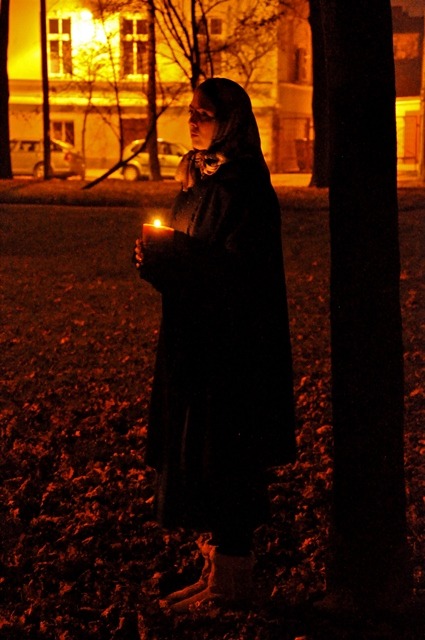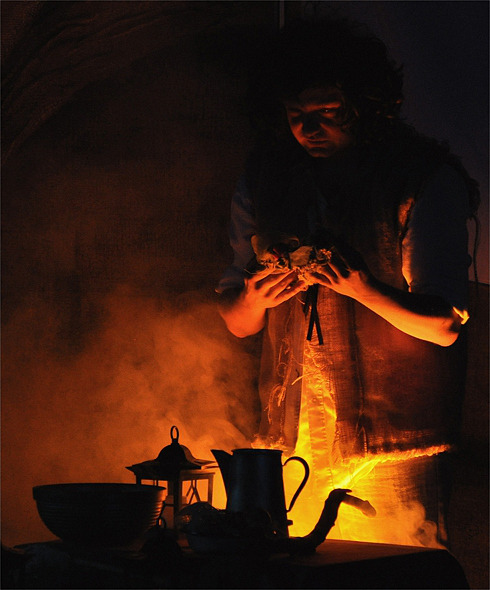#dziady



Cicho wszędzie głucho wszędzie (Felicjan’s modest outfit for Zaduszki or Dziady, the Polish day of the dead.)
Ból, gorcz, cierpienie, muszą też towarzyszyć ludzkiemu losowi, aby móc odczuć właściwy smak szczęścia.
Dziady /Zaduszki/Pominki - remnants of an ancient Slavic feast celebrated in Poland to commemorate the dead. Dziady are usually translated as “Forefathers’ Eve” in the English langauge.
The old customs have merged with the celebrations of the Christian All Souls’ Day (in Polish: Dzień Zaduszny or simply Zaduszki), held on the 2nd November, a day after the All Saints’ Day. During those two significant days the Polish people travel even to the other side of the country just to pray and light a znicz(grave candle) on the graves of their relatives and friends.
The custom dates back to the pre-Christian times and the old-Slavic traditions of the ancestor worship, the cult of the dead and of the afterlife. Even in the 19th century numerous Polish ethnographers were describing that the common people were “still believing” in the death being just a natural form of a transition into the outerworld, seen as interwoven with the world of the living. Souls were seen as eternal and never perishing, being able to move between the worlds freely in certain conditions. People were looking after and praying to their relatives’ souls above all, and believing in a certain form of a return that could be compared to reincarnation - souls being able to come back within their ród (a word meaning roughly a bloodline / kinship / tribe) - another sign of the strong connection of the worlds of the living and the dead in the Slavic spirituality. Many people would also pray to the “abandoned” souls, which were spirits of those people who didn’t have anyone living left on the earth to look after them.
People were very particular about preparing the right form of the parting ceremonies, but also about the wellness of the souls - for example greeting them during the many forms of the Dziady feasts throughout the year, in hope for their supervision or guardianship. And in the very complex Slavic spiritual world and folklore there was a lot to guard from.
Sickness and unfortunate events were feared more than the death itself. Souls of those people who passed away in an “unnatural” death or too early (in a very young age), and also souls of the various criminals, all were considered restless spirits, unfullfilled or unclean ones. Slavic folklore is full of such mythological creatures - for example the well-known rusałka ortopielec, who were the souls of the drowned; boginka, who was a soul of a woman died during the labour; wampir orstrzyga, who were people that e.g. died by suicide or weren’t buried or burnt properly after the death.
Fear of the restless forces was constant and so strong that some smaller protective rites were common even in the everyday life. People believed that any kind of spirit / soul should be taken care of, and any good or bad one could be appeased by gifts but also enraged by the mistreatment or forgetfulness.
The meaningful Dziady feasts were dedicated solely for the souls of the relatives and the name Dziady itself could be translated as “Forefathers”. Originally, Dziady were held at least 4 times a year - during the new moon around the winter & summer solstices and the autumn & spring equinoxes. These four dates were seen as very powerful in the nature-oriented Slavic spirituality and the new moon was the best time for the souls to arrive, not to be troubled by the strong moonlight.
The fixed date of 2nd November, combined with the Christian feast of the All Faithful Departed, had begun to be established around the 14th century in Poland, but even in the 19th century or early 20th century many people were still performing the old rites. Naturally, over the centuries under Christianity the rites were slowly getting detached from their original meaning. Later the feast was called Zaduszki (translated as a feast for the souls - “dusze” or “duszki”) or in some regions of Poland: Pominki,WspominkiorWypominki (derived from the word “pamiętać” = “to remember”). In some parts of Poland it was also believed that the strongest time for the incarnation of the visiting souls - the real night of Dziady - would be the the Eve before the All Saints Day, the night between the 31st October and 1st November.
During the Zaduszki, that special transitional time of the year, souls of the dead would return freely to the world of the living. They would often visit the places where they used to live, wander around their favourite locations or just around the cemetery, they would also visit various old places of cult (for example churches). People were getting prepared for the souls’ visit - cleaning up the houses, leaving small treats of food and drinks, also placing lit candles around in order to help them warm up. A way to a destination would be often lit with many candles arranged in a row along the path. Satisfying those basic needs of the souls was meant to comfort them but also to ensure their assistance or counsel in the future.
An interesting aspect of the souls’ visit was ther “materiality”. People believed that the souls could sometimes appear looking like the living humans. They could try to get inside the buildings as semi-material beings, for instance through the cracks in the walls. People would often leave the doors or windows slightly open during the Dziady rite in order to help the souls get inside.
After Dziady the conductor (usually the oldest and wisest person) would often sweep the floor to “remove” the remaining souls who didn’t want to go back to the outerworld. Some souls would even “hide” in the furnitures though, preferably in the main dining table where the whole family gathered, and people would sometimes “keep” them if feeling that they are friendly. The most common remnant of that custom in Poland is the popular “odpukiwanie w drewno” (“knocking on wood”) - unwittingly, the Polish people would usually knock on the underside of the wooden tabletop. In the old days it was a way of “waking up” the soul hidden there, a protective spirit meant to help preventing the negative factors.
On pictures:
Expanded version of this old article on my wordpress:
Post link
polish dark academia story where a group of students decides to recreate dziady according to mickiewicz’s play for laughs but they end up accidentally summoning actual ghosts and, amongst them, the one of said poet himself








